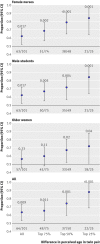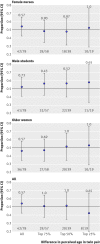Perceived age as clinically useful biomarker of ageing: cohort study
- PMID: 20008378
- PMCID: PMC2792675
- DOI: 10.1136/bmj.b5262
Perceived age as clinically useful biomarker of ageing: cohort study
Abstract
Objective: To determine whether perceived age correlates with survival and important age related phenotypes.
Design: Follow-up study, with survival of twins determined up to January 2008, by which time 675 (37%) had died.
Setting: Population based twin cohort in Denmark.
Participants: 20 nurses, 10 young men, and 11 older women (assessors); 1826 twins aged >or=70.
Main outcome measures: Assessors: perceived age of twins from photographs. Twins: physical and cognitive tests and molecular biomarker of ageing (leucocyte telomere length).
Results: For all three groups of assessors, perceived age was significantly associated with survival, even after adjustment for chronological age, sex, and rearing environment. Perceived age was still significantly associated with survival after further adjustment for physical and cognitive functioning. The likelihood that the older looking twin of the pair died first increased with increasing discordance in perceived age within the twin pair-that is, the bigger the difference in perceived age within the pair, the more likely that the older looking twin died first. Twin analyses suggested that common genetic factors influence both perceived age and survival. Perceived age, controlled for chronological age and sex, also correlated significantly with physical and cognitive functioning as well as with leucocyte telomere length.
Conclusion: Perceived age-which is widely used by clinicians as a general indication of a patient's health-is a robust biomarker of ageing that predicts survival among those aged >or=70 and correlates with important functional and molecular ageing phenotypes.
Conflict of interest statement
Competing interests: None declared.
Figures



References
-
- Borkan GA, Norris AH. Assessment of biological age using a profile of physical parameters. J Gerontol 1980;35:177-84. - PubMed
-
- Christensen K, Iachina M, Rexbye H, Tomassini C, Frederiksen H, McGue M, et al. “Looking old for your age”: genetics and mortality. Epidemiology 2004;15:251-2. - PubMed
-
- Rexbye H, Petersen I, Johansens M, Klitkou L, Jeune B, Christensen K. Influence of environmental factors on facial ageing. Age Ageing 2006;35:110-5. - PubMed
-
- McGue M, Christensen K. Social activity and healthy aging: a study of aging Danish twins. Twin Res Hum Genet 2007;10:255-65. - PubMed
-
- Sherertz EF, Hess SP. Stated age. N Engl J Med 1993;329:281-2. - PubMed
Publication types
MeSH terms
Grants and funding
LinkOut - more resources
Full Text Sources
Other Literature Sources
Medical
